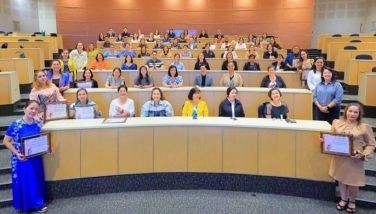Breaking the fast for Doreen

I’ve been on a fast. Nothing to do with faith, rather a belief in the efficacy of the tabula rasa principle as in preparing oneself as a clean slate or scraped tablet for an expectedly fresh and substantial codification. Aw, heck, might as well say it in plain language.
I’m revving up for this Thursday’s expected feast at Cafe 1771, formerly Chateau 1771 (at the El Pueblo complex on Julia Vargas corner ADB Ave.) specifically on the 2nd floor or wine area, starting promptly at 12 noon. I’ll be with fast friends I like being with, albeit we see one another only twice a year at least, unless we go bump in the night at a grocery or wet market.
Over a long, slow luncheon (as differentiated from lunch), Micaela Fenix Makabenta or Micky, Felice Sta. Maria, Maya Besa Roxas, Manolo “Mol” Fernando and I will have food, talk about food, fantasize on other food, and eventually deliberate on the comparative qualities of food essays to come up with the winners for this year’s Doreen G. Fernandez Food Writing Contest Awards.
It’s on its eighth year. And what do you know the date for this judges’ luncheon had to be pushed back several times until it fell quite felicitously on Doreen G. Fernandez’s natal day!
She would have been 76, her niece Maya tells us. This much-loved lady was of course synonymous to food and food research and writing, apart from various other cultural concerns she had been a vital part of, in the fields of academe and journalism.
 In Hawaii in the late 1990s, Doreen is feted with a lei and encomiums at a culture conference.
In Hawaii in the late 1990s, Doreen is feted with a lei and encomiums at a culture conference.Doreen it was who first got me to teach in Ateneo, at the time she headed the communications department. In her characteristically affable, gentle, and most centered manner, she quickly assured me that it would be a breeze, because she would not impose any parameters on whichever way I decided to handle the workshop course on essay-writing.
That was well over a dozen years ago, when one could still smoke in class (well, at the com dept. building, it was pretty laid back, maybe owing to its relative isolation from the campus hub, surrounded by trees and open spaces), and traffic hadn’t quite built up yet inside or outside campus.
I’d pop in at Doreen’s office before the week’s session, and her hail-fellow-well-met personality would bubble up from behind her desk and papers, cheer me up with a string of bon mots whether they revolved around tsismis, chica, chicanery, “chick lit,” or the chiaroscuro cum colorful chronicles of a lifestyle built around the arts. A truly learned one she was, of a solid foundation of insatiably enriched knowledge about our country’s more spiritual leanings than anything the CBCP can try to dictate or foment.
Yes, Doreen G. Fernandez was a very centered (as opposed to self-centered) individual who gave of her time and devotion and made everyone happy that we were all learning from her.
When she passed away, Micky organized the DGF Food Writing Contest Awards in tribute to the fine lady who had first drawn the Pinoy food map and charted its historical, epicurean, and highly personalized territories.
We’ve been meeting every year since, although we’ll be missing Anvil Publishing’s Karina Bolasco this week since she’s casing book joints in the US. We decide on a particular theme or area of Pinoy cooking, and Micky sends out the call for entries: essays of roughly 800 words dwelling on the prescribed area of delectability.
In 2008 it was on soups. Last year it was about cookies. The awardees were: first place “In Search of the Perfect Uraro” by Violeta de Guzman (who also won first place the previous year for “Purboy”); second place “The Bread of Angels” by Herschel A. Tan (an accounting student!); and third place “Operation Sagip Biskwit” by Jennifer L. Peña (director of communications for the Inter-Continental Manila Hotel). Awarded honorable mentions were “Biscocho Pasuquin” by Elmer I. Nocheseda and “Barques” by Cheryl Chan Nolasco.
The awards dinner was held at Cirkulo Restaurant on Arnaiz or Pasay Road. Since it was held sometime in the latter part of November, we were treated to a special Thanksgiving turkey dinner menu created by chef Jay Gamboa:
Asparagus salad with eggs and roasted garlic vinaigrette; roasted carrot soup with goat cheese croutons; apple wood smoke roasted turkey with giblet gravy and dried cranberry compote; mushroom and pancetta stuffing; green beans with maple pecan butter; gratin potatoes; white chocolate bread pudding with homemade ice cream; pumpkin pie; coffee or tea; and a wine selection that featured Dog Point Sauvignon Blanc 2008 and Saintsbury Garnet Carneros Pinot Noir 2006.
See, a splendid menu never escapes my pornographic memory. Why, I can even tell you how many seconds or thirds I had of each luscious item.
This year, it’s “Breakfast” that takes centerstage. As in agahan or almusal. That is why I am breaking my fast at that luncheon, where we’ll be selecting the winners from 40 charming entries.
So far, I’ve read all about Lola’s breakfast, Pangasinense breakfast, breakfast with monks, sinangag, gatas ng kalabaw, a love affair with longganiza, malunggay for breakfast, mountain breakfast, South Cotabato breakfast, the whole-log enchilada (tapsilog, tocilog, bangsilog, atbp.), lugaw, goto atbp., daing for breakfast, peanut butter and guava jelly sandwich, poor man’s breakfast, almusal al fresco, the Capampangan’s paksing bangus for breakfast, Laguna Lake sabawan, the pamahaw or Ilonggo breakfast, Muslim Mindanao breakfast...
To wit, on the last, an excerpt:
“For centuries, the ubiquitous patil has been a staple in the Maguindanaon’s quotidian first meal. It has served as gustatory fuel for farmhand and datu alike. For the datu, patil was usually made of chicken, whereas a simpler version was made of fish. As stalwarts of tradition, our old babus (aunts) cooked chicken in ground turmeric powder, crushed ginger, salt, and lana tidtu (coconut oil). They would then shred the chicken into a kagikit. The kagikit was browned in oil and neatly tucked on top of a mound of cooked glutinous rice. The rice was then placed on a trimmed banana leaf brushed with rendered chicken fat or lana tidtu. The banana leaf was tightly rolled into a cylinder and fastened with string. Finally, it was briefly grilled on burning coconut shells, thus imparting a muted smokiness to the delicacy. It is the unique construction of the patil that makes it an ideal snack for travelers; furthermore, the condensation of the hot rice inside the banana leaf lends a unique flavor that flirts with fermentation.”
Hmm. Darn it, yummy!
Here’s another mouth-watering excerpt:
“Also on the table was paksiw. Anduhaw, a silver fish, had been simmered in coconut vinegar. Several cloves of crushed garlic, slices of ginger, and a long hot pepper had been added to the broth. Chopped eggplant and ampalaya had also been mixed in, and finally oil was drizzled atop the paksiw once it was done. This dish embodied the Surigao breakfast.
“(W)e also ate buyad, or sundried squid, and daing of danggit that was paired with paco, steamed curly ferns, and a salad of seaweed that looked like miniature green grapes. Eggs from native chicken were fried. I pierced the bright persimmon colored yolk of my egg until it ran like syrup over the rice. It is slightly sweeter than the regular variety... better than pancakes with maple syrup. I paired the slickness with the crispiness of torta of dumudot, or fried anchovy cakes that resembled ukoy and which I dipped into a sawsawan of palm vinegar, sili and garlic.
“... At the end of the meal, we had a choice of sweets... There was moron, naturally purple glutinous rice, grown on the mountainsides nearby. It had been boiled with brown sugar and coconut milk and then steamed in banana leaves. Budbud and sayonsong similar versions with white rice or cassava were placed at the table.
“... I paid attention to what we ate every morning. There were certain dishes like rice, the paksiw, the buyad and the tinuya as well as the fruits and vegetables that were served every day. The dishes that accompanied them changed. Sometimes we enjoy torta of talong, boiled saba with ginamos, or cured anchovies, or giniling na baboy, or ground pork sautéed with longbeans and chilis. These were the vertebrae of our mornings.”
Hah! The “vertebrae of our mornings” indeed! I can appreciate that, even if my vertebrae are habitually horizontal for much of most mornings. One learns something every day: one can actually eat a moron!
Now, I’m not saying that these entries are already winners in my list, since I still have to go through others. But they do get to show the delicacy of variety that we peruse and gorge on every year, and how we are constantly enlightened on the richness of our culture, how all our islands have something to offer that we still render in italics, but which cause us to salivate over the prospects of getting up to speed on virginal experiences for our tongues and palates.
We have plans to compile and sift through the hundreds of entries we’ve received and come up with a book tentatively titled “Rice Cake Dreams” in time for publication by 2012, which will be the 10th year of the Doreen G. Fernandez Food Writing Contest.
Only fitting. This Thursday we offer a toast to the fine memory of one grand lady.
Happy Burpday, Doreen!



















